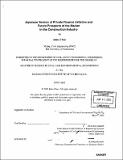Japanese version of private finance initiative and future prospects of the market in the conduction industry
Author(s)
Choo, Imho, 1968-
DownloadFull printable version (11.49Mb)
Other Contributors
Massachusetts Institute of Technology. Dept. of Civil and Environmental Engineering.
Advisor
Fred Moavenzadeh.
Terms of use
Metadata
Show full item recordAbstract
During the past decade in Japan, the sluggish economy has increased pressure on the nation's finance and had a negative impact on the public investment decision of the government. This has led to a reduced construction budget responding to the continuing slump with an expansion in public works investment. Since the end of World War II, the Japanese government has issued a huge amount of debt to finance public works. As a result, the total debt (the government bonds, loans payable, and government short term securities, or financing bills) added up to over 140% of GDP in 2002. To overcome the economic crisis, since June 2001, the Koizumi Cabinet has advanced wide-ranging structural reforms. Those include economic revitalization strategies, tax reform and reforms in major government expenditures expressed as a commitment to small government. As a part of these reform policies, the government has focused on the Private Finance Initiative (PFI) in order to rebuild national and local government economy with the purpose of achieving better partnerships between public and private sectors. Since the PFI Law went into effect in September 1999 there were 98 PFI deals, including 9 services started, 21 contracts completed and 68 guidelines announced for projects in Japan by March 2002. The increased level of activity is expected to continue and the relationship between public and private sector must change to meet the complex and challenging market needs as the market grows in the future. This thesis analyzes the current environment surrounding the Japanese PFI market and the current issues concerning basic components of the PFI such as "Value For Money" or risk transfer. This thesis also examines future possibilities for expanding the Japanese Version of PFI in the construction market and proposes possible areas for private financing including renewal works for aged infrastructure in the Japanese and overseas construction market.
Description
Thesis (S.M.)--Massachusetts Institute of Technology, Dept. of Civil and Environmental Engineering, 2003. Includes bibliographical references (p. 128-129).
Date issued
2003Department
Massachusetts Institute of Technology. Department of Civil and Environmental EngineeringPublisher
Massachusetts Institute of Technology
Keywords
Civil and Environmental Engineering.